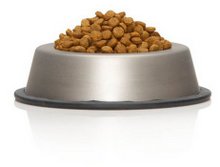Dog Nutrition Puts You in an Awkward Position

Here’s a common scenario: you’re at the supermarket in the dog food aisle. You’re looking at a bunch of different brightly colored bags, labeled with funny terminology you don’t quite understand. One reads, “All-Natural Puppy Food for Large Breeds” another says, “Holistic Lamb and Rice for Smaller Dogs.” Meanwhile, you’re left wondering which one offers the most nutrition for dogs. All of these bags seem virtually the same so you grab the one with the most recognizable name.
Sound familiar?
 Keeping up with nutritional value is hard enough to do in your own diet; knowing the facts about nutrition for dogs means adding another mouth with significantly sharper teeth into the mix. That’s a sure recipe for confusion. All of these odd little labels and miniscule differences between largely identical name brands is enough to make anybody’s head spin. Fortunately, there is a wealth of information online to help you traverse the maze of mongrel mastication. Unfortunately, it’s still pretty complicated. So in the interest of brevity, here are some of the most important considerations when shopping for a nutritious dog food.
Keeping up with nutritional value is hard enough to do in your own diet; knowing the facts about nutrition for dogs means adding another mouth with significantly sharper teeth into the mix. That’s a sure recipe for confusion. All of these odd little labels and miniscule differences between largely identical name brands is enough to make anybody’s head spin. Fortunately, there is a wealth of information online to help you traverse the maze of mongrel mastication. Unfortunately, it’s still pretty complicated. So in the interest of brevity, here are some of the most important considerations when shopping for a nutritious dog food.
What Are Your Nutrient Needs?
When it comes to nutrition for dogs, you must first know what you’re looking for. It’s easy to forget because of their uniform geniality, but dogs are actually individuals. If you’re dog has joint problems, needs a shinier coat, is still growing, is elderly, has urinary tract problems, and so on—these are things you need to consider. Think of any nutrient needs or special attributes of your dog and take those into account before purchasing their food.
Holistic, Organic, and All Natural Shenanigans
The next thing to do is avoid the marketing schemes. Believe it or not, there is no law or regulation in place to keep greedy dog food makers from placing meaningless labels onto their products. The terms “Holistic” and “Organic” mean effectively nothing when stamped on the side of your favorite puppy chow. They are undefined and disingenuous. “All Natural” is kind of tricky too. It can mean that there aren’t any synthetic ingredients in the feed, but it can also mean there is only a small amount.
place to keep greedy dog food makers from placing meaningless labels onto their products. The terms “Holistic” and “Organic” mean effectively nothing when stamped on the side of your favorite puppy chow. They are undefined and disingenuous. “All Natural” is kind of tricky too. It can mean that there aren’t any synthetic ingredients in the feed, but it can also mean there is only a small amount.
Look for Nutritional Value
Thirdly, read the ingredient list. A good indicator is if they have a meat, fish, egg, or some type of meat meal or fish meal as either the first or second ingredient. These are high quality foodstuffs that provide plenty of nutrition for dogs. There will also be a percentage of each ingredient listed. Check this an make sure that at least 10% of the dog’s daily diet, by weight, would be protein, and 5.5% would be fat.
Lastly, keep this quick list of helpful dog nutrition tips in mind:
Sound familiar?
 Keeping up with nutritional value is hard enough to do in your own diet; knowing the facts about nutrition for dogs means adding another mouth with significantly sharper teeth into the mix. That’s a sure recipe for confusion. All of these odd little labels and miniscule differences between largely identical name brands is enough to make anybody’s head spin. Fortunately, there is a wealth of information online to help you traverse the maze of mongrel mastication. Unfortunately, it’s still pretty complicated. So in the interest of brevity, here are some of the most important considerations when shopping for a nutritious dog food.
Keeping up with nutritional value is hard enough to do in your own diet; knowing the facts about nutrition for dogs means adding another mouth with significantly sharper teeth into the mix. That’s a sure recipe for confusion. All of these odd little labels and miniscule differences between largely identical name brands is enough to make anybody’s head spin. Fortunately, there is a wealth of information online to help you traverse the maze of mongrel mastication. Unfortunately, it’s still pretty complicated. So in the interest of brevity, here are some of the most important considerations when shopping for a nutritious dog food.What Are Your Nutrient Needs?
When it comes to nutrition for dogs, you must first know what you’re looking for. It’s easy to forget because of their uniform geniality, but dogs are actually individuals. If you’re dog has joint problems, needs a shinier coat, is still growing, is elderly, has urinary tract problems, and so on—these are things you need to consider. Think of any nutrient needs or special attributes of your dog and take those into account before purchasing their food.
The next thing to do is avoid the marketing schemes. Believe it or not, there is no law or regulation in
 place to keep greedy dog food makers from placing meaningless labels onto their products. The terms “Holistic” and “Organic” mean effectively nothing when stamped on the side of your favorite puppy chow. They are undefined and disingenuous. “All Natural” is kind of tricky too. It can mean that there aren’t any synthetic ingredients in the feed, but it can also mean there is only a small amount.
place to keep greedy dog food makers from placing meaningless labels onto their products. The terms “Holistic” and “Organic” mean effectively nothing when stamped on the side of your favorite puppy chow. They are undefined and disingenuous. “All Natural” is kind of tricky too. It can mean that there aren’t any synthetic ingredients in the feed, but it can also mean there is only a small amount.Look for Nutritional Value
Thirdly, read the ingredient list. A good indicator is if they have a meat, fish, egg, or some type of meat meal or fish meal as either the first or second ingredient. These are high quality foodstuffs that provide plenty of nutrition for dogs. There will also be a percentage of each ingredient listed. Check this an make sure that at least 10% of the dog’s daily diet, by weight, would be protein, and 5.5% would be fat.
Lastly, keep this quick list of helpful dog nutrition tips in mind:
- Wet food- more fat and protein than dry food. It therefore costs more, and requires less feeding per meal than dry food. Although it’s mostly water and not usually recommended by vets.
- Semi-wet food- will always contain a sugar preservative
- Dry food -will always contain starch
- Look for the AAFCO statement. This shows that the food is approved by a governing body.





 All posts
All posts Tips and Tricks
Tips and Tricks Health and Welling
Health and Welling Product Reviews
Product Reviews Funny and Quirky
Funny and Quirky





